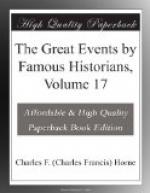The news of the gold discoveries near Bathurst had soon spread through the Australian colonies. The more adventurous of the colonists started at once for the diggings. Others, often encouraged by their governments, who foresaw a constant drain of population in favor of the gold colony, endeavored to find gold within their own limits. Rumors of discoveries were constantly arising. Gold was found at Echuca in South Australia, in the Fingal district of Tasmania, and in the Curumandel ranges of New Zealand. But none of these discoveries could compare for a moment with those which took place within the newly constituted colony of Victoria. Even so early as August, 1851, gold had been worked at a place called “Deep Creek” (or “Anderson’s Creek"), not far from Melbourne, but this was soon abandoned in favor of the diggings at Clunes, on the headwaters of the streams which flow north from the great dividing range to the Murray River. A month later, these again were temporarily deserted in favor of the rich Buninyong district, just south of the range, whose chief centre was Ballarat. Finally, at the beginning of October, 1851, the wonderful finds at Mount Alexander, a spur of the Macedon range to the north of Melbourne, were eclipsing all previous discoveries.
Before the end of the year the export of gold from Victoria alone had very nearly reached half a million in value. In two years the population of the Victorian gold-fields almost equalled the whole population of the colony at the close of 1850. Most of the diggers lived in tents, and had absolutely no interest in the colony beyond the mere hope of profit from the diggings. If a more profitable field had opened elsewhere, they would have left at once. By the end of the year 1851 the probable area of future discoveries was pretty well recognized. The gold-fields, with few exceptions, were found to lie on one side or the other of the eastern Cordillera or chain of mountains which, beginning with Mount Elliot in Northern Queensland, follows the coast with remarkable precision till it reaches Port Phillip Bay. But all the more northerly part of this chain was unexplored in 1851, and of course there was room for almost any development within such wide limits.
Warned by events in New South Wales, the governments of the other Australian colonies had made preparations for the crisis. Western Australia was too remote to be much affected; and her newly arrived supply of convict labor rendered her contented. But South Australia and Tasmania suffered severely from the drain of population, which set in toward the diggings.
In South Australia, the effect was in some districts almost as if a pestilence had swept away the men, leaving the women and children untouched. Some of the emigrants really deserted their families, but the bulk were honorable men, and remittances of gold soon began to find their way to Adelaide for distribution among relatives in the colony.




